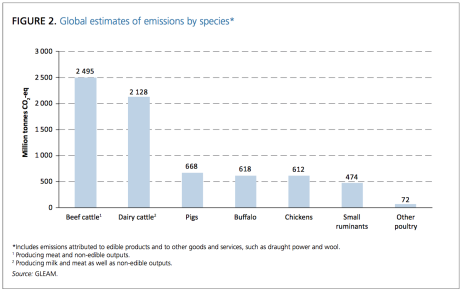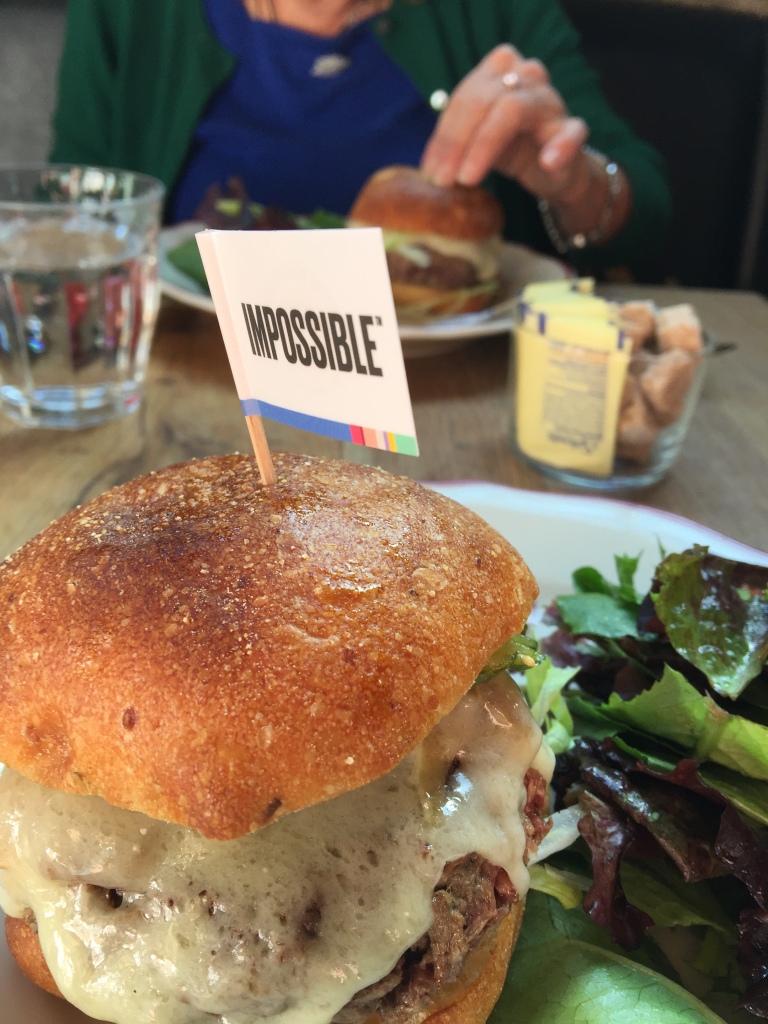How I survived Eating the Impossible Burger
Daniel Westcott
When I sunk my teeth into the Impossible Burger, I didn’t realize that I was risking my life.
I’ve got a family that depends on me, work that I feel is important and had I been more informed, I may have eaten something else.
You see, the Impossible Burger contains an additive called leghemoglobin. “Leg” for legume, like peas or lentils, “heme” for iron, and “globin” for globular protein. It’s an iron carrying protein globulin that was originally found in soybeans. Leghemoglobin, and its near twin, hemoglobin release their iron-containing heme molecule when cooked. Heme makes meat-magic happen. It gives red meat its red color, and is responsible for enhancing the aroma and flavor. My body produces a nearly identical molecule called hemoglobin. And while any meat that I would choose to eat contains oodles of hemoglobin, the source for the Impossible Burger’s heme-carrying protein has raised safety concerns among some.
Using genetic engineering, the people at Impossible Foods have introduced a soybean gene that encodes leghemoglobin into yeast. They then grow the yeast and extract the leghemoglobin protein. This is the same process that’s been used to provide human insulin to diabetics for 30 years. However, this time, the process has been adapted to make burgers. After growing the yeast and extracting the protein, the leghemoglobin is added to the Impossible Burger to give it aroma and flavor that’s missing from other veggie burgers.
This isn’t the first time that genetic engineering has been used to make food. Prior to genetic engineering, most cheeses were made with animal-based rennet, an enzyme that causes milk to form curds. The most abundant source for rennet is in the stomach of a nursing calf. The only way to get to this source is to slice the baby cow open. The calves do not survive this process. Many cheeses still use animal-based rennet. These days, using genetic engineering, cheese makers can use yeast to provide an animal-free source of rennet. Oddly enough, organic cheese manufacturers aren’t required to disclose the source of their rennet, and many of them prefer the yeast-derived version.
So, when Impossible Foods adds leghemoglobin to their burger, they are embracing the controversial technique of genetic engineering. By distributing this techno-burger to various high-end restaurants in New York, L.A., and the East Bay they’ve exposed thousands of affluent people to the “risk” of undue heme exposure. But, if you’re an adventurous vegetarian who feels the need to experience this meat mimic, I’ll tell you how I walked out of the restaurant with my health intact.
I chewed. I savored the taste. I swallowed…. And then…
That was it. All I had to do to survive the Impossible was to eat it. It was delicious.
Let’s pause here, because I’ll need to put down my pseudo-alarmism and be more honest. I loved the Impossible Burger. I’m supportive of the approach, the methods, the food, and the goals of Impossible Foods. This company, started by a respected and successful scientist, Pat Brown, aims to reduce the number of cows on the planet. This isn’t a side-effect of selling vegetable-based burgers; it is an explicit goal.
Meat production is terrible for the environment and is a contributing factor to climate change. In 2013, the United Nation’s Food and Agriculture Organization released a report on the impacts of cattle on the environment. Nearly 2,500 million tons of CO2 equivalents are produced by raising beef cattle per year. You would need to drive your car the distance from Earth to the moon 25 times to release an equivalent amount of CO2. With increasing demand for beef, due to new markets in developing countries, the impact of this sector needs our attention now.

Michael Eisen, a UC Berkeley scientist, consultant for Impossible Foods, and 2018 Senatorial hopeful, says that the beef industry is ripe for disruption. He points to the fact that this industry works on very thin profit margins. The industry uses all parts of the cow, and bits that they wouldn’t normally be able to sell are tossed into the grinder and sold at a low cost. The sales of ground beef help to prop up the more expensive and less profitable premium cuts of beef. This makes the industry very price sensitive.
So, Impossible Foods is targeting their profit margins. By providing plant-based meat, and yes, they call their product “meat”, they aim to reduce livestock production on two fronts. The first and most obvious one is the direct route of putting alternatives into the hands of consumers. As Eisen says, “Don’t convince people to stop eating meat, give them an alternative.”
The second, and economically devious, approach is to remove the ability of ground beef to offset the cost of high-end beef. If you compete with the cheapest part of the beef industry, you compete with the whole cow. This has the potential to make prime cuts of beef more expensive, pushing people back to the less expensive ground beef. And right there in the ground beef section of the cooler, they’ll be confronted with a choice: Buy ground cow meat, or ground plant “meat.” If the flavors and prices are comparable, internal research by Impossible Foods suggests that people will choose their ground plant burger over ground beef.
If you compete with the cheapest part of the beef industry, you compete with the whole cow.
If you, like me, accept the fact that climate change is the major challenge that humanity faces, you can see the appeal of this approach. A reduction in meat production means a reduction in land use dedicated to growing fodder for meat, reductions in the potent greenhouse gas methane, reductions in water use, and other beneficial knock-on effects.
People have very real concerns about the adoption and use of genetic engineering. How can we ever be absolutely sure that a new product is safe? The concern for safety and the safety of our families and the environment is paramount. When slick advertisements continually push the message that new is the same thing as better, we’ve got every right to be suspicious. This suspicion grows exponentially when companies are not straightforward on how they derive the things that they want us to put in our bodies. I fully agree that consumers must do their homework rather than accepting claims without scrutiny.
And here, I think Impossible Foods is really attempting the seemingly impossible. If you visit the FAQs section of their website, you see the question: “Do you produce heme by genetic modification?” and the straightforward answer: “Yes.” They aren’t attempting to obscure the fact that they use genetic engineering or genetic modification. They don’t make it a selling point. Given the current attitudes towards the technology, what company would? But they’ve accepted the two impossible tasks of disrupting the meat industry and openly selling a genetically engineered product to very savvy customers.
What genetic engineering entails remains unfamiliar to many people. But, the cases of insulin and rennet demonstrate that it can be used safely, as it has been for almost 30 years. This class of protein in particular, globin, is present in all plants, animals, bacteria, and archaea. We already consume a form of it with every meal. Our bodies break down and metabolize it without incident, no matter the source. The real risks that we must focus on are the risks of unmitigated climate disaster. In my opinion, this burger is one small step towards that end.
But absolutists, who oppose anything genetically engineered or modified are unable to see potential benefits in this technology. Instead of uniting to fight climate change in any way possible, they raise the specter of allergies to heme. An allergy to heme would be as likely as an allergy to oxygen. It’s a vital and indispensable part of life. The differences between hemoglobin and leghemoglobin are insignificant, especially when you consider where this leghemoglobin ends up, the harsh environment of your stomach which is specialized in breaking down these types of proteins, no matter the source.
In short, the debate about the safety of leghemoglobin is a Nothing Burger.



I agree that there is no evidence that casts doubt on the safety of leghemoglobin derived from GM yeast. Nor is there any theoretical reason to believe that it would be hazardous to human health, since it is a nature-identical protein from a plant that we eat. I found the Friends of the Earth press release on this topic to be misleading and alarmist, and the NY Times article had similar problems. Both sources made it sound as though Impossible Foods was somehow circumventing FDA requirements and releasing a dangerously untested product, but that is not the case. This is a situation where biotechnology has the potential to confer real environmental benefits, i.e., encouraging the consumption of plant-based rather than animal-based protein, so it is disappointing to hear a chorus of opposition on the grounds that all GMOs are too risky. As you say, climate change seems like a far more clear and present danger.
LikeLiked by 1 person
I believe calling this product “meat” or “burger” is just lying and meant to deceive consumers. That is factual truth after all you have to sell this as if it were but it is not. Lets be honest the “saving of the environment” is a great catalyst for making billions. If anyone believes it is not about making money consult Santa and the Easter Bunny i’m sure you believe there real also. Let the product stand alone on its own without the gimmicks and drama that we are all going to die if we don’t. Stop using “meat” and “burger”. Educated people know that it is not and “impossible” is used because it baits the consumer to buy. After all if there logo was “Plant Patty” enriched by GMO ingredients it wouldn’t sell. Please stop the deception. Also stop using the worst cuts of beef and pork as a comparison for nutritional information its cheating in a way and deceiving. With all that being said its obvious the use of “marketing buzz words and comparisons” are the strongest part of many articles about the imitation and fake meat products. Lets be brave and call these lines of products what they are “Imitation” not “Impossible”.
LikeLike
Hi Jon,
Here’s some more information on the impact of the diet of the world on climate: https://www.nature.com/articles/d41586-019-02409-7
I too wish that we could let products sell themselves. I find advertising in general to be a distasteful attempt at manipulating behavior in service of quarterly profits. However, accepting that advertising is here to stay, and just the sea that we swim in, using advertising and marketing in service of a beneficial outcome is okay with me. If Impossible doesn’t advertise or market their products, I doubt that the rest of the protein market would follow suit. If they make some money at it, it will inspire the more risk-averse entrepreneurs to take a shot at it. This could provide more choices, and less animal products in our diet. If you look over the link I posted, you may agree that it’s a good thing.
I don’t think anyone buying the Impossible burger is under the impression that they are purchasing animal products. It isn’t a trick.
I think the use of the word “meat” is an attempt to get people to think about what meat is. What unites the things that fall under the term “meat?” They came from an animal? Fish are animals. Are fish meat? No. Fish is seafood. There’s a whole class of pescatarians out there. Nobody gives them any trouble.
So, if meat isn’t defined simply on the animal nature of it… what is it? Composition?
What about this as a thought experiment. If you carefully made all of the proteins, fats, and other molecules in a steak, and created something that was 100% identical to steak, would that be meat? If no… then it isn’t the stuff inside the meat… it’s something else.
If it’s cultural.. then we can change culture.
LikeLike
Daniel, where did you have the opportunity to try the burger?
LikeLike
I went to Cockscomb in the SF financial district
LikeLike
What you are mainly communicating Daniel is your absolute ignorance in health or science for that matter. This is an anecdote that has absolutely no value as scientific evidence unless the burger had a very strong effect and caused you to have an anaphylactic reaction. However the most challenging aspects if medicine whether we are discussing toxicity, allergenicity, drug benefits and risks are medium sized effects which are only detectable with large blinded controlled trials which do not exist for any GMOs. So thanks for highlighting why academic scientists such as Michael Eisen ( an expert in fly genomes list I checked ) and plant scientist should NEVER be listened to when they are pontificating in a field of medicine. There are good reasons there are licensed medial doctors and PhDs ( who are not doctors) and you ‘ve just highlighted it beautifully.
LikeLike
Ad hominem attacks don’t refute the fact that heme, hemoglobin, and leghemoglobin are all very digestible molecules. You’re welcome to argue on the merits of the science.
LikeLike